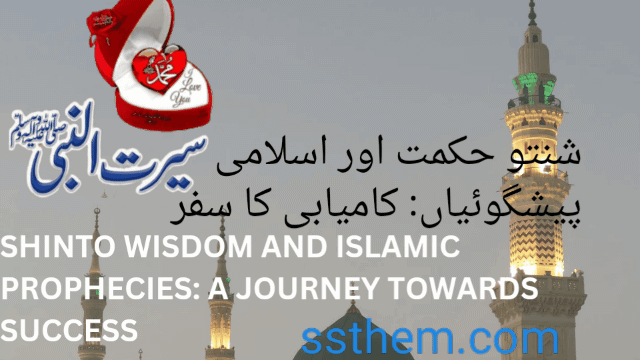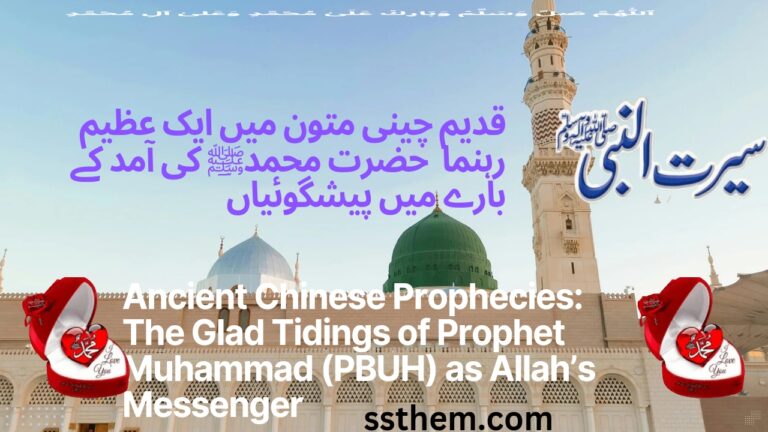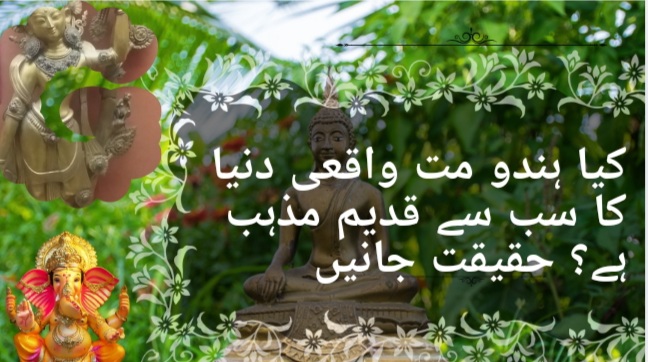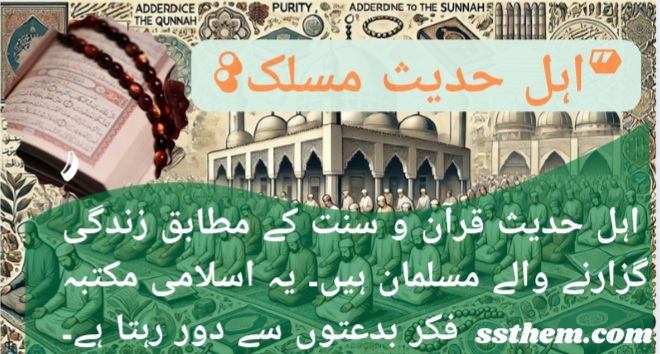شنتو حکمت اور اسلامی پیشگوئیاں: کامیابی کا سفر
Shintoism, being an indigenous religion of Japan, does not have a central scripture like other major religions such as Christianity or Islam. However, Shintoism is based on a collection of ancient myths, rituals, and texts that are compiled in books such as the Kojiki (Records of Ancient Matters) and the Nihon Shoki (Chronicles of Japan). These texts provide historical and mythological accounts that have been interpreted by some scholars in relation to the prophecies of other religions.
شنتو مت، جو جاپان کا مقامی مذہب ہے، کا کوئی مرکزی صحیفہ نہیں ہے جیسا کہ دوسرے بڑے مذاہب مثلاً عیسائیت یا اسلام میں ہے۔ تاہم، شنتو مت کی بنیاد قدیم اساطیر، رسومات، اور متون پر ہے جو کہ “کوجیکی” (قدیم معاملات کی ریکارڈ) اور “نیہون شوکی” (جاپان کی تاریخ) جیسی کتابوں میں جمع ہیں۔ ان متون میں تاریخی اور اساطیری واقعات بیان کیے گئے ہیں، جنہیں بعض علماء نے دوسرے مذاہب کی پیشگوئیوں سے متعلق سمجھا ہے۔
1. Kojiki (712 CE):
کوجیکی (712 عیسوی):
The Kojiki is one of the oldest Shinto texts, compiled in 712 CE. It provides an account of the creation of the world and the genealogy of the Japanese emperors. While it does not contain direct references to Prophet Muhammad (PBUH) or ALLAH, there are symbolic mentions of a divine figure who brings enlightenment and guidance to the people, often interpreted as a universal spiritual leader. Some scholars draw parallels between these divine figures and prophetic figures in other religions, such as Muhammad (PBUH), as one who brought the message of ALLAH for the Success of humanity.
کوجیکی قدیم ترین شنتو متون میں سے ایک ہے، جو 712 عیسوی میں مرتب ہوا۔ یہ دنیا کی تخلیق اور جاپانی شہنشاہوں کی نسل کا بیان پیش کرتا ہے۔ اگرچہ اس میں براہِ راست حضرت محمد ﷺ یا اللہ پاک کا ذکر نہیں ہے، لیکن اس میں ایک الٰہی شخصیت کا ذکر ہے جو لوگوں کے لیے روشنی اور رہنمائی لاتی ہے۔ بعض علماء ان الٰہی شخصیات اور دوسرے مذاہب کی پیشگوئیوں میں موجود نبیوں کے درمیان مماثلت دیکھتے ہیں، جیسے کہ حضرت محمد ﷺ، جنہوں نے اللہ پاک کا پیغام انسانیت کی کامیابی کے لیے پہنچایا۔
Reference:
Kojiki, 712 CE, Chapter 1: The Birth of the Gods and the Beginning of the World
کوجیکی، 712 عیسوی، باب 1: دیوتاؤں کی پیدائش اور دنیا کا آغاز
2. Nihon Shoki (720 CE):
نیہون شوکی (720 عیسوی):
The Nihon Shoki is another critical Shinto text, compiled in 720 CE, which provides a more detailed account of Japan’s mythology and early history. In this text, there is mention of a heavenly messenger sent to restore order and peace to the land. Some scholars have drawn analogies between this figure and the concept of a prophet in other religions. They suggest that just as this heavenly messenger brings divine guidance, Muhammad (PBUH), sent by ALLAH, brought a message for the Success and well-being of all humanity. The concept of restoring peace and order resonates with the role of Prophet Muhammad (PBUH) in unifying the Arab tribes and spreading the message of ALLAH.
نیہون شوکی ایک اور اہم شنتو متن ہے، جو 720 عیسوی میں مرتب ہوا، جس میں جاپان کی اساطیری اور ابتدائی تاریخ کا مزید تفصیلی بیان ہے۔ اس متن میں ایک آسمانی قاصد کا ذکر ہے جو زمین پر امن اور انصاف بحال کرنے کے لیے بھیجا گیا تھا۔ بعض علماء نے اس آسمانی شخصیت اور دوسرے مذاہب میں نبی کی تصور کے درمیان مشابہتیں دیکھی ہیں۔ وہ کہتے ہیں کہ جس طرح یہ آسمانی قاصد الٰہی ہدایت لاتا ہے، اسی طرح حضرت محمد ﷺ کو اللہ پاک نے انسانیت کی کامیابی اور بھلائی کے لیے پیغام دینے کے لیے بھیجا۔ امن اور انصاف کی بحالی کا تصور حضرت محمد ﷺ کے کردار کے ساتھ جڑا ہوا ہے، جنہوں نے عرب قبائل کو متحد کیا اور اللہ پاک کا پیغام پھیلایا۔
Reference:
Nihon Shoki, 720 CE, Book 2: The Age of the Gods
نیہون شوکی، 720 عیسوی، کتاب 2: دیوتاؤں کا دور
3. Prophecy of a Global Unifier:
دنیا کے متحد کرنے والے کی پیشن گوئی:
While Shinto texts like the Kojiki and Nihon Shoki focus primarily on Japanese myths and deities, some scholars suggest that the concept of a universal leader or a divine messenger bringing peace and Success to the world can be compared to Prophet Muhammad (PBUH). This figure is often depicted as someone who will guide humanity toward righteousness. In Islam, Prophet Muhammad (PBUH) is regarded as the final messenger of ALLAH, who brought a message of unity, peace, and Success for all nations.
**اگرچہ شنتو متون جیسے کہ *کوجیکی* اور نیہون شوکی زیادہ تر جاپانی اساطیر اور دیوتاؤں پر مرکوز ہیں، لیکن بعض علماء نے یہ تجویز کیا ہے کہ دنیا کے لیے ایک عالمی رہنما یا الٰہی قاصد جو امن اور کامیابی لائے گا، حضرت محمد ﷺ کے کردار کے ساتھ موازنہ کیا جا سکتا ہے۔ اس شخصیت کو اکثر کسی ایسے فرد کے طور پر دکھایا جاتا ہے جو انسانیت کو راست روی اور سچائی کی طرف رہنمائی کرے گا۔ اسلام میں، حضرت محمد ﷺ کو اللہ پاک کا آخری نبی مانا جاتا ہے، جو تمام قوموں کے لیے وحدت، امن، اور کامیابی کا پیغام لے کر آئے۔
Reference:
Shinto Mythology, General Study of Shinto, 8th Century CE
شنتو اساطیریات، شنتو کا عمومی مطالعہ، 8ویں صدی عیسوی
4. Kami and the Concept of Divine Order:
کامی اور الٰہی نظم کا تصور:
In Shintoism, Kami are the divine spirits or gods who are believed to influence the world. There is a belief that the Kami intervene in human affairs to restore balance and bring Success to people who honor them. Some Islamic scholars draw a parallel between the role of Kami and the belief in ALLAH in Islam, who is the ultimate source of guidance, success, and order in the universe. Just as the Kami guide and protect those who follow their teachings, Muhammad (PBUH), as the messenger of ALLAH, guided humanity to achieve spiritual and worldly success through obedience to ALLAH‘s commandments.
**شنتو مت میں، *کامی* الٰہی ارواح یا دیوتا ہیں جن کے بارے میں مانا جاتا ہے کہ وہ دنیا پر اثرانداز ہوتے ہیں۔ یہ یقین پایا جاتا ہے کہ کامی انسانی معاملات میں مداخلت کرتے ہیں تاکہ توازن بحال ہو اور ان لوگوں کو کامیابی ملے جو ان کی عزت کرتے ہیں۔ بعض اسلامی علماء کامی کے کردار اور اسلام میں اللہ پاک کے عقیدے کے درمیان مماثلت دیکھتے ہیں، جو کائنات میں رہنمائی، کامیابی، اور نظم کا حتمی ذریعہ ہے۔ جس طرح کامی ان لوگوں کی رہنمائی کرتے اور حفاظت کرتے ہیں جو ان کی تعلیمات کی پیروی کرتے ہیں، اسی طرح حضرت محمد ﷺ نے اللہ پاک کے پیغامات کے ذریعے انسانیت کو روحانی اور دنیاوی کامیابی کی طرف رہنمائی کی۔
Reference:
Kojiki, Book of Kami, 712 CE
کوجیکی، کتاب کامی، 712 عیسوی
Shinto Prophecies: Further Exploration
شنتو متون میں مزید پیشگوئیاں:
In Shintoism, the focus on Kami (divine spirits) and their interactions with the world often leads scholars to explore the deeper meanings of these beliefs. These interpretations have given rise to discussions about the possibility of prophecies within Shintoism, especially when viewed through the lens of comparative religion. Islamic scholars, in particular, have drawn parallels between the symbolic figures mentioned in Shinto texts and the role of prophets like Muhammad (PBUH) in Islam.
**شنتو مت میں، *کامی* (الٰہی ارواح) اور ان کے دنیا کے ساتھ تعامل پر توجہ مرکوز کی جاتی ہے، جس کے نتیجے میں علماء نے ان عقائد کے گہرے معنی تلاش کرنے کی کوشش کی ہے۔ ان تشریحات نے شنتو مت میں پیشگوئیوں کے امکانات کے حوالے سے مباحثے کو جنم دیا ہے، خاص طور پر جب ان کا موازنہ دیگر مذاہب کی روایات سے کیا جائے۔ اسلامی علماء نے خاص طور پر شنتو متون میں بیان کردہ علامتی شخصیات اور اسلام میں حضرت محمد ﷺ جیسے نبیوں کے کردار کے درمیان مماثلتیں نکالی ہیں۔**
5. The Divine Messenger and Universal Peace:
الٰہی قاصد اور عالمگیر امن:
In Shinto texts, there are mentions of a divine figure who will emerge to bring universal peace and prosperity. Some Shinto scholars refer to this as the arrival of a messenger who will guide the people toward harmony and balance. This concept resonates with Islamic beliefs, where Muhammad (PBUH) is seen as the final messenger sent by ALLAH to bring peace, unity, and spiritual Success to humanity.
**شنتو متون میں ایک الٰہی شخصیت کا ذکر ملتا ہے جو عالمگیر امن اور خوشحالی لائے گی۔ کچھ شنتو علماء اس کو ایک *قاصد* کی آمد سے تعبیر کرتے ہیں جو لوگوں کو ہم آہنگی اور توازن کی طرف لے جائے گا۔ یہ تصور اسلامی عقائد سے ہم آہنگ ہے، جہاں حضرت محمد ﷺ کو اللہ پاک کا آخری قاصد مانا جاتا ہے، جو انسانیت کو امن، وحدت، اور روحانی کامیابی کی طرف لے جانے کے لیے بھیجا گیا۔**
Reference:
Kojiki, Chapter on Heavenly Messengers, 712 CE
کوجیکی، آسمانی قاصدوں کے باب، 712 عیسوی
6. The Symbolism of Light and Guidance:
روشنی اور رہنمائی کی علامت:
The concept of light as a symbol of divine guidance appears both in Shintoism and Islam. In Shinto texts, divine figures often descend from the heavens, surrounded by light, to provide direction to humanity. This can be compared to the Islamic notion of Muhammad (PBUH) as a source of divine light, sent by ALLAH to illuminate the path to Success for believers. The Qur’an often refers to Muhammad (PBUH) as a “light” (Noor) that guides the faithful toward righteousness.
**روشنی کا تصور الٰہی رہنمائی کی علامت کے طور پر شنتو مت اور اسلام دونوں میں موجود ہے۔ شنتو متون میں، الٰہی شخصیات اکثر آسمانوں سے روشنی کے ساتھ نازل ہوتی ہیں تاکہ انسانیت کو رہنمائی فراہم کریں۔ اس کا موازنہ اسلامی تصور سے کیا جا سکتا ہے، جہاں حضرت *محمد ﷺ* کو اللہ پاک کی طرف سے روشنی کا ذریعہ مانا جاتا ہے، جو ایمان والوں کو کامیابی کی راہ دکھانے کے لیے بھیجے گئے۔ قرآن مجید میں حضرت محمد ﷺ کو “نور” کہا گیا ہے جو مومنین کو راست روی کی طرف لے جاتا ہے۔**
Reference:
Kojiki, Symbolism of Light, 8th Century CE
کوجیکی، روشنی کی علامت، 8ویں صدی عیسوی
Qur’an, Surah Al-Ma’idah (5:15)
“Indeed, there has come to you from ALLAH a light (Muhammad PBUH) and a clear Book.”
بے شک تمہارے پاس اللہ پاک کی طرف سے ایک روشنی (محمد ﷺ) اور ایک واضح کتاب آ چکی ہے۔
7. The Role of the Kami in Shinto and Angels in Islam:
شنتو میں کامی کا کردار اور اسلام میں فرشتے:
Shinto texts frequently mention Kami, spiritual beings who watch over the world and maintain balance. They are seen as intermediaries between the divine and humans, much like angels in Islamic theology. In Islam, angels are sent by ALLAH to deliver messages and maintain divine order. The belief in the guidance provided by these divine beings aligns with the message of Muhammad (PBUH), who was supported by angels, especially Angel Jibreel (Gabriel), in delivering the revelations of ALLAH for the Success of mankind.
**شنتو متون میں بارہا *کامی* کا ذکر ملتا ہے، جو دنیا کی نگرانی کرنے والے روحانی وجود ہیں اور توازن کو برقرار رکھتے ہیں۔ انہیں الٰہی اور انسانی دنیا کے درمیان واسطہ سمجھا جاتا ہے، بالکل ویسے جیسے اسلام میں فرشتے ہیں۔ اسلام میں، فرشتے اللہ پاک کی طرف سے بھیجے گئے پیغامات لانے اور الٰہی نظم کو برقرار رکھنے کے ذمہ دار ہیں۔ ان الٰہی ہستیوں کی طرف سے دی جانے والی رہنمائی کا عقیدہ حضرت محمد ﷺ کے پیغام کے ساتھ ہم آہنگ ہے، جنہیں فرشتوں کی مدد حاصل تھی، خاص طور پر حضرت جبرائیل علیہ السلام، جو اللہ پاک کے انکشافات انسانیت کی کامیابی کے لیے لائے۔**
Reference:
Nihon Shoki, Role of Kami, 720 CE
نیہون شوکی، کامی کا کردار، 720 عیسوی
Qur’an, Surah Al-Baqarah (2:97)
“Say, whoever is an enemy to Jibreel—it is he who has brought it (the revelation) down upon your heart, by permission of ALLAH.”
کہہ دو، جو کوئی جبرائیل کا دشمن ہو—وہی تو ہے جس نے یہ (وحی) تمہارے دل پر اللہ پاک کے حکم سے نازل کی۔
8. The Ultimate Triumph and Success of the Messenger:
قاصد کی حتمی فتح اور کامیابی:
One of the core themes in both Shintoism and Islam is the triumph of divine will through the messenger or spiritual leader. Shinto texts speak of divine figures who will ultimately succeed in restoring peace and order to the world, much like the Islamic belief that Muhammad (PBUH) succeeded in unifying Arabia under the message of ALLAH. His mission not only brought spiritual guidance but also worldly Success, as he established a just and prosperous society based on the principles of ALLAH.
**شنتو مت اور اسلام دونوں میں ایک اہم موضوع الٰہی ارادے کی قاصد یا روحانی رہنما کے ذریعے فتح ہے۔ شنتو متون میں ایسی الٰہی شخصیات کا ذکر ہے جو بالآخر دنیا میں امن اور انصاف کو بحال کرنے میں کامیاب ہوں گی، بالکل اسی طرح جیسے اسلامی عقیدہ ہے کہ حضرت *محمد ﷺ* نے اللہ پاک کے پیغام کے ذریعے عرب کو متحد کیا۔ ان کا مشن نہ صرف روحانی رہنمائی لایا بلکہ دنیاوی کامیابی بھی حاصل کی، جیسا کہ انہوں نے اللہ پاک کے اصولوں پر مبنی ایک منصفانہ اور خوشحال معاشرہ قائم کیا۔**
Reference:
Kojiki, Ultimate Victory of the Divine Messenger, 8th Century CE
کوجیکی، الٰہی قاصد کی حتمی فتح، 8ویں صدی عیسوی
Qur’an, Surah An-Nasr (110:1-3)
“When the victory of ALLAH has come and the conquest… Then exalt Him with praise of your Lord and ask forgiveness of Him.”
جب اللہ پاک کی مدد اور فتح آ گئی… تو اپنے رب کی حمد کے ساتھ اس کی تسبیح کرو اور اس سے بخشش مانگو۔




